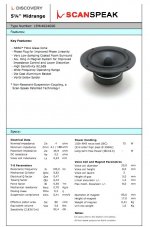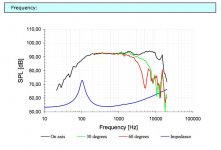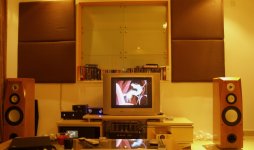I hope to end up at 87dB @ 2.83V / 1m. Yes, 3 liters may be too small but making the sphere big makes is more prone to reflexion. I have to experiment. What whould you use ?
5 liters ? Maybe with some damped holes in the back. I may also mount the midrange slighty angled so that it is closer to the tweeter.
I used this trick in my Sonics Allegria speaker and got a nice off axis behaviour for free.
The midrange already a little off axis i got a more homogenious output over angle.
5 liters ? Maybe with some damped holes in the back. I may also mount the midrange slighty angled so that it is closer to the tweeter.
I used this trick in my Sonics Allegria speaker and got a nice off axis behaviour for free.
The midrange already a little off axis i got a more homogenious output over angle.
This is also a low difraction design but i used the minimum baffle priciple without any roundings. Nevertheless the speakers " disappear" well. In the ZDL i will try to go closer to the ideal.
When you compare my measurements of the Scan Wideband to the measurements in the Scan Speak lab you can see that the samples i got have a higher breakup frequency. Maybe in the meantime they where able to improve the coating.
When you compare my measurements of the Scan Wideband to the measurements in the Scan Speak lab you can see that the samples i got have a higher breakup frequency. Maybe in the meantime they where able to improve the coating.
Attachments
It seems to me a 3" driver would do much better unless you are looking for certain max SPL at a certain low frequency. How is the scan large signal performance, have you done any Klippel testing?
Last edited:
The Scan wideband can go surprisingly loud. It has a very strong neodymium motor and a wide linear throw. When it reaches the end stop it makes a short burst of sound that is not too unpleasant but that has to be avoided though. I think for nearfield listening under 2m it will be loud enough. If that is not enough i have an alternative strategy with an aditional upper midrange dome from Morel and a 15cm midrange, also from Scan. I will look up the catalogs and post the specs. You have not answered my question about the volume for the Scan though.
I looked at the specs of 10F/4424G00 a bit more, the cutout hole is only 3mm larger than what I normally see people call 3" drivers. Sd seems to be about the same as what I use, F0 is also about the same. So maybe 3 liter enclosure is fine. Calling this a 4" driver is exaggerating it, no?🙄The Scan wideband can go surprisingly loud. It has a very strong neodymium motor and a wide linear throw. When it reaches the end stop it makes a short burst of sound that is not too unpleasant but that has to be avoided though. I think for nearfield listening under 2m it will be loud enough. If that is not enough i have an alternative strategy with an aditional upper midrange dome from Morel and a 15cm midrange, also from Scan. I will look up the catalogs and post the specs. You have not answered my question about the volume for the Scan though.
Since the size is similar. I think the CSD is not so good as shown on Zaph Audio site. The flat on-axis response means more beaming at the higher frequencies. The driver I use was like that until we changed the dust cap.
Could you send me an ULR to the Zaph measurements on the Scan ?
I can not find them on the Zaph website.
Other then a small discontinuity in the 1 to 2kHz range i see no reason why the CSD should be bad.
I can not find them on the Zaph website.
Other then a small discontinuity in the 1 to 2kHz range i see no reason why the CSD should be bad.
That measurements look fine to me and my sample does not have the 8kHz peak. The energy storage over 6 Khz is normal and i will not use that range anyway.
I have played that driver on an open baffle to 100 + professionals and semi professionals
on ETF in France and got very posive commends so i already know that this is a fine driver. I also tried the Fountek FR88EX. Soundwise it has a slightly more open character because of the thin aluminum diafragm but the dynamic range of that driver is too restricted to be usefull here. There is a new Fountek driver with more throw but i have not tried it out so far. A metal cone may also not be a good match to a softdome concerning mix of materials.
I have played that driver on an open baffle to 100 + professionals and semi professionals
on ETF in France and got very posive commends so i already know that this is a fine driver. I also tried the Fountek FR88EX. Soundwise it has a slightly more open character because of the thin aluminum diafragm but the dynamic range of that driver is too restricted to be usefull here. There is a new Fountek driver with more throw but i have not tried it out so far. A metal cone may also not be a good match to a softdome concerning mix of materials.
Yes, different driver have different stengths and weaknesses.
I have used the Beston ribbon tweeter with metal cone drivers crossed at some where between 8KHz~10KHz with very positive results. So as long as the drivers decay fast enough, mismatch between material normall will not be an issue. Many lower cost driver spec the linear excursion by difference between VC length and gap length. This is much more conservative than the standard way. The important thing is how it behave after it starts to leave the gap, thiws is where Klippel testing is very valuable.
An externally hosted image should be here but it was not working when we last tested it.
I have used the Beston ribbon tweeter with metal cone drivers crossed at some where between 8KHz~10KHz with very positive results. So as long as the drivers decay fast enough, mismatch between material normall will not be an issue. Many lower cost driver spec the linear excursion by difference between VC length and gap length. This is much more conservative than the standard way. The important thing is how it behave after it starts to leave the gap, thiws is where Klippel testing is very valuable.
Last edited:
One of my test articles a few years ago that was not good enough.😉 Some further improvements were acceptable, work is still commensing on a more optimized version. Some studies show that Ted Jordan was on the right track for wide band performance.
I have worked with Jordan units on and off for the last 35 years. My first unit was the Jordan-Watts module, then i had several versions of his 50mm unit including Bandors and i also have the newer 13cm unit. I find his work also interesting and nowerdays a lot of companies offer similar drivers like Fountek, Mark Audio, Tang-Band etc.
Non of this drivers has the high efficiency of the Scan wideband though and when you run them wideband there maybe still a slight metallic aftertaste. Trust me, until i arived at the Scan, i tried out virtually everything. For my ear and measurement equipment it is the most natural sounding of the lot.
Non of this drivers has the high efficiency of the Scan wideband though and when you run them wideband there maybe still a slight metallic aftertaste. Trust me, until i arived at the Scan, i tried out virtually everything. For my ear and measurement equipment it is the most natural sounding of the lot.
The scan driver has that voltage sensitivity due to low impedance. So it's hard to compare. Yes, the metallic aftertaste takes some more skills to improve. Although I have eliminated a significant portion of it to be hard to detect, I still look forward to reduce it even more. It's very hard to find existing drivers that perform to my requirements, some can be used with slight design modification. Yes, I have also measured and listened to some Scan drivers along other drivers as well. The ones I measured an listened to are good, but that last touch of recording background is still lacking for my taste. BTW, here is a partial of my Jordan collection.
Back in the 80's when I asked Ted for more data, he sent me a letter suggesting that I do my own measurements aside from those published at the time. I have always kept that letter as a reminder.
From recentl tests and listening, I have found that most metallic and harsh sound from stiff diaphragm drivers actually reflect problems in other areas. One significant aspect is the interface between equipment. Properly tuned interface solves a big part of the problem.
An externally hosted image should be here but it was not working when we last tested it.
Back in the 80's when I asked Ted for more data, he sent me a letter suggesting that I do my own measurements aside from those published at the time. I have always kept that letter as a reminder.
From recentl tests and listening, I have found that most metallic and harsh sound from stiff diaphragm drivers actually reflect problems in other areas. One significant aspect is the interface between equipment. Properly tuned interface solves a big part of the problem.
Last edited:
I agree, drivers with metal cones have better resolution of micro detail and i use metal cone drivers successfully in several of my commercial designs. I also agree that you always hear the complete chain and of cause the loudspeakers are acused first to have a fault whereas the problem can come from somewhere else. The Scan also has very good resolution of detail although a metal cone digs deeper. I use it because the crossover is maybe better to handle and the sensitivity is higher although it is a 4 Ohm design. There is a Viva unit with a similiar membrane and then you can see the diffrerence.
This is the driver i am talking about :
http://www.tymphany.com/files/TG9FD-10-04 Rev1_0.pdf
It is also a 4 Ohm design, uses a very similiar membrane but has 3dB less sensitivity then the Scan.
To my surprise Tymphany renamed all drivers "Peerless" so the Vifa brand of speakers does not seem to exist any more.
http://www.tymphany.com/files/TG9FD-10-04 Rev1_0.pdf
It is also a 4 Ohm design, uses a very similiar membrane but has 3dB less sensitivity then the Scan.
To my surprise Tymphany renamed all drivers "Peerless" so the Vifa brand of speakers does not seem to exist any more.
Hi,
Funny, I am just listening to a pair of speakers that where made to make the best out of what I had at hand or could easily and cheaply get, so no claims for breaking new ground or making ultimate performance stuff or anything...
They combine a circular magnetic planar (a better performance version of the original Emit-R) tweeter with a 15cm Metal Cone fullrange and 26cm Metal Cone woofer, using a first order series crossover at around 250Hz/2500Hz acoustically, all units in positive polarity, in an Avalonish style (those stealth like chevrons etc) enclosure.
They do sound rather good, much better than their earlier incarnation in a narrow box with the woofer in the side and a parallel crossover with bass and treble out of phase. And that despite so many metal cones and so low order crossovers without any traps or such...
Sensitivity is a measily 88dB/2.83V and impedance is a rather flat (except BR-LF peaks) 4 Ohm. It surprised me just how much better the series x-over works in a minimalist context... I tried them before and this is the first time I got a series X-O to work the way those who rave about them claim they always do...
Ciao T
I agree, drivers with metal cones have better resolution of micro detail...
Funny, I am just listening to a pair of speakers that where made to make the best out of what I had at hand or could easily and cheaply get, so no claims for breaking new ground or making ultimate performance stuff or anything...
They combine a circular magnetic planar (a better performance version of the original Emit-R) tweeter with a 15cm Metal Cone fullrange and 26cm Metal Cone woofer, using a first order series crossover at around 250Hz/2500Hz acoustically, all units in positive polarity, in an Avalonish style (those stealth like chevrons etc) enclosure.
They do sound rather good, much better than their earlier incarnation in a narrow box with the woofer in the side and a parallel crossover with bass and treble out of phase. And that despite so many metal cones and so low order crossovers without any traps or such...
Sensitivity is a measily 88dB/2.83V and impedance is a rather flat (except BR-LF peaks) 4 Ohm. It surprised me just how much better the series x-over works in a minimalist context... I tried them before and this is the first time I got a series X-O to work the way those who rave about them claim they always do...
Ciao T
Attachments
😀Hi,
... I tried them before and this is the first time I got a series X-O to work the way those who rave about them claim they always do...
Ciao T
Thorsten, you have to be carefull when you compare series to parallel xovers. With the same on axis response the off axis response is rather different so one could compare aples to oranges. Anyway, if your speakers sound good with moderate effort i congratetulate you.
Even with the same order XO at the same frequency? I am interested in hearing more. Having always designed with series XO and always had all drivers in the same polarity, I really have not explored the differences.Thorsten, you have to be carefull when you compare series to parallel xovers. With the same on axis response the off axis response is rather different so one could compare aples to oranges. Anyway, if your speakers sound good with moderate effort i congratetulate you.
- Status
- Not open for further replies.




